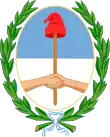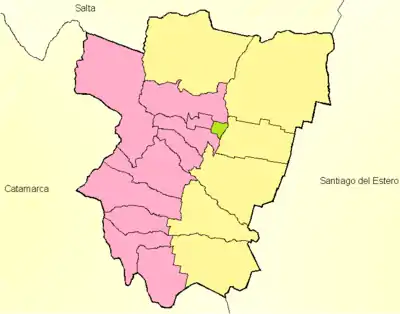Legislature of Tucumán
The Honourable Legislature of Tucumán Province (Spanish: Honorable Legislatura de la Provincia de Tucumán) is the unicameral legislative body of Tucumán Province, in Argentina. It convenes in the provincial capital, San Miguel de Tucumán.
Legislature of Tucumán | |
|---|---|
 | |
| Type | |
| Type | |
| Leadership | |
President (Vice Governor) | |
Substitute President | |
First Vice President | |
| Structure | |
| Seats | 49 legislators |
 | |
Political groups | Government (34)
Opposition (15)
|
Length of term | 4 years |
| Authority | Constitution of Tucumán |
| Elections | |
| Proportional representation | |
Last election | 9 June 2019 |
Next election | 2023 |
| Website | |
| legislaturadetucuman | |
It comprises 49 legislators, elected in three multi-member electoral sections through proportional representation every four years. Elections employ the D'Hondt system.[1] The electoral sections do not correspond to the 17 departments of Tucumán, but rather group different departments together.[2]
Its powers and responsibilities are established in the provincial constitution. The legislature is presided by the Vice Governor of Tucumán (presently Osvaldo Jaldo of the Justicialist Party), who is elected alongside the governor.[3]
History
The first legislative body in Tucumán was the Hall of Representatives, which convened for the first time on 25 January 1822, during the governorship of José Víctor Posse to write the first Constitution of Tucumán. During its first years of existence, the Hall of Representatives clashed with the colonial ayuntamiento, which did not yet recognize its authority. The Hall's work was interrupted by the period of anarchy that followed the uprising led by Martín de Bustamante. A new legislature would not convene until 7 January 1823.[4]
The new constitution of the province, adopted in 1884, established a bicameral legislature comprising a Senate and a Chamber of Deputies. The Chamber of Deputies was due to be made up of one member for every six thousand inhabitants in the province, who would serve for three-year terms, and would be allowed to run for re-election. In addition, the Chamber would use staggered elections and renew a third of its members every year. The Senate, on the other hand, would count with one member for every 12 thousand inhabitants, who would serve for four-year terms and be allowed to run for re-election. The Senate would also count with staggered elections, and a fourth of its members would be renewed every year. A constitutional reform in 1907 extended legislative terms for both senators and deputies to four years, and established staggered elections by halves every two years.[4]
This system was in place until 1990, when a new constitutional reform established a single legislative chamber by the name of "Honourable Legislature", counting with 40 members who would be elected for four-year terms and allowed to run for re-election.[4]
Electoral sections
| Electoral Section |
Departments | Legislators | Map |
|---|---|---|---|
| I – Capital | 19 |  | |
| II – Este | 12 | ||
| III – Oeste | 18 | ||
| Total | 49 | ||
References
- "Tucumán". Observatorio Electoral Argentino CIPPEC (in Spanish). Retrieved 1 February 2022.
- "Guía Electoral". Atlas Electoral Tucumán (in Spanish). Retrieved 1 February 2022.
- "Honorable Legislatura de la Provincia de Tucumán". Legislaturas Conectadas (in Spanish). Retrieved 1 February 2022.
- "HISTORIA DEL PODER LEGISLATIVO". Honorable Legislatura de Tucumán (in Spanish). Retrieved 1 February 2022.
External links
- Official website (in Spanish)
- Constitution of Tucumán Province (in Spanish)